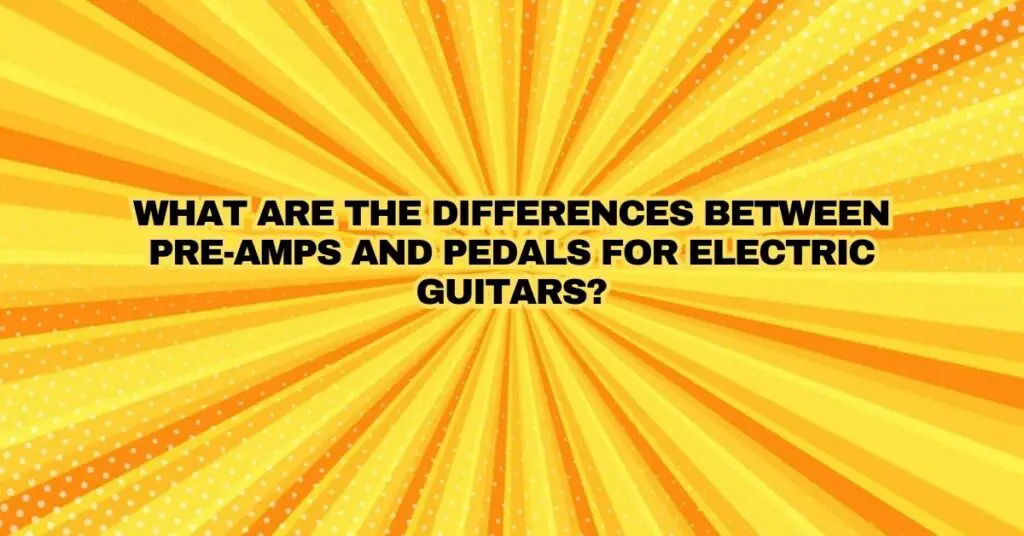Electric guitarists are always in search of ways to shape and enhance their sound. Two common tools in the guitarist’s arsenal for achieving this are preamps and pedals. Preamps and pedals serve distinct purposes when it comes to modifying the guitar’s tone and are essential components of any electric guitarist’s setup. In this comprehensive guide, we will delve into the differences between preamps and pedals, helping you understand when and how to use each to achieve the desired sonic effects.
Understanding Preamps
A preamp, short for “preamplifier,” is a device that amplifies and shapes the incoming electrical signal from your guitar before it reaches the main amplifier. Preamps can be built into amplifiers or exist as standalone units. Here are some key attributes of preamps:
1. Signal Amplification:
The primary function of a preamp is to boost the relatively weak signal produced by your guitar’s pickups to a level suitable for further processing or amplification. This amplification helps maintain signal integrity and prevents signal loss in long cable runs.
2. Tone Shaping:
Preamps often include tone controls like EQ (equalization) adjustments for bass, midrange, and treble frequencies. These controls allow you to sculpt your guitar’s sound, emphasizing or de-emphasizing certain tonal characteristics.
3. Clean Gain:
Many preamps offer clean gain, which means they can increase the volume of your signal without adding distortion or saturation. This is useful for achieving a pure, unaltered boost in volume.
4. Impedance Matching:
Preamps can help match the impedance of your guitar’s output to the input of your amplifier. Proper impedance matching ensures that your guitar’s signal transfers efficiently, preserving tone and clarity.
5. Versatility:
Preamps are versatile tools that can be used in various settings, including recording studios, live performances, and home practice setups. They are particularly useful for acoustic-electric guitars, where the onboard preamp shapes the guitar’s tone before it’s amplified.
Understanding Pedals
Guitar pedals, also known as stompboxes, are individual effects units that can be connected between your guitar and amplifier. They come in various forms, each designed to create specific sonic effects. Some key characteristics of guitar pedals include:
1. Effects Processing:
Pedals are designed to create specific effects such as distortion, overdrive, delay, reverb, chorus, phaser, flanger, and more. They modify the guitar’s signal in unique ways to produce a wide range of sounds.
2. On/Off Control:
Pedals are typically foot-operated, allowing you to turn effects on or off as needed during a performance. This on-the-fly control gives you the ability to change your sound instantaneously.
3. Signal Chain:
Pedals are used within a signal chain, which refers to the order in which they are connected. The order of pedals can significantly impact the resulting sound. For example, placing a distortion pedal before a delay pedal will yield a different sound compared to the reverse order.
4. Sonic Experimentation:
Guitarists often use pedals to experiment with their sound. Pedals provide endless possibilities for creative expression, allowing you to explore different tones, textures, and atmospheres.
5. Compact and Portable:
Pedals are compact and portable, making them an excellent choice for musicians who need to transport their gear frequently, such as touring artists.
Differences and Applications
Now that we’ve covered the basic attributes of preamps and pedals, let’s delve into the key differences and their respective applications.
1. Function:
- Preamps: Primarily focus on boosting and shaping your guitar’s signal, emphasizing clean gain and tonal control.
- Pedals: Specialize in creating specific effects, from distortion and modulation to time-based effects like delay and reverb.
2. Tone Shaping:
- Preamps: Offer more general tone-shaping controls, typically with EQ adjustments to control bass, midrange, and treble frequencies.
- Pedals: Provide dedicated controls for the specific effect they produce, allowing precise manipulation of that particular sonic characteristic.
3. On/Off Control:
- Preamps: Typically remain on during your entire performance or recording session.
- Pedals: Can be engaged or disengaged individually, providing dynamic control over when the effect is active.
4. Sound Variety:
- Preamps: Tend to offer cleaner, more transparent tonal enhancement and are excellent for maintaining the guitar’s core sound.
- Pedals: Offer a wide range of unique and distinct sounds, allowing for creative exploration and experimentation.
5. Signal Chain:
- Preamps: Typically placed at the beginning of the signal chain, enhancing the guitar’s raw tone before any effects are applied.
- Pedals: Positioned in various locations within the signal chain, depending on the desired sound and effect interaction.
When to Use Each:
- Preamps: Use preamps when you want to clean up and boost your guitar’s signal without adding specific effects. This is ideal for preserving the natural sound of your instrument while shaping it to your preferences.
- Pedals: Incorporate pedals when you aim to add unique effects to your sound, from classic distortion or overdrive to time-based effects like delay and reverb. Pedals are perfect for experimenting with various sonic textures and tones.
Combining Preamps and Pedals:
It’s common for guitarists to use both preamps and pedals in their setups. For example, you might use a preamp to shape your core tone and then introduce pedals to add specific effects. This combination provides a balance between the purity of your guitar’s tone and the creative possibilities of effect processing.
Conclusion: Crafting Your Unique Sound
The decision between using preamps and pedals ultimately depends on your goals and preferences as a guitarist. Preamps excel at boosting and shaping your guitar’s natural tone, while pedals offer a vast array of creative effects. Many guitarists find that a well-balanced combination of both preamps and pedals allows for the ultimate versatility and sound exploration. Experiment with different setups to find the sound that resonates with you, and remember that the beauty of electric guitar playing lies in its capacity for limitless sonic creativity.


